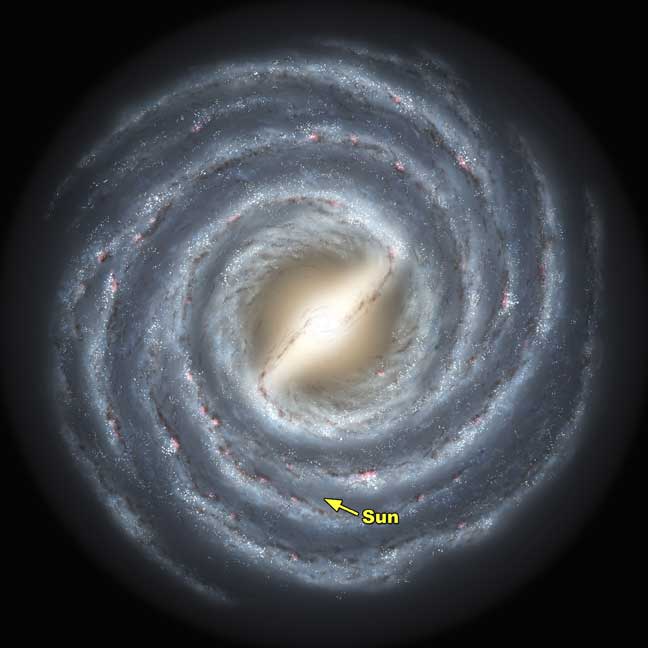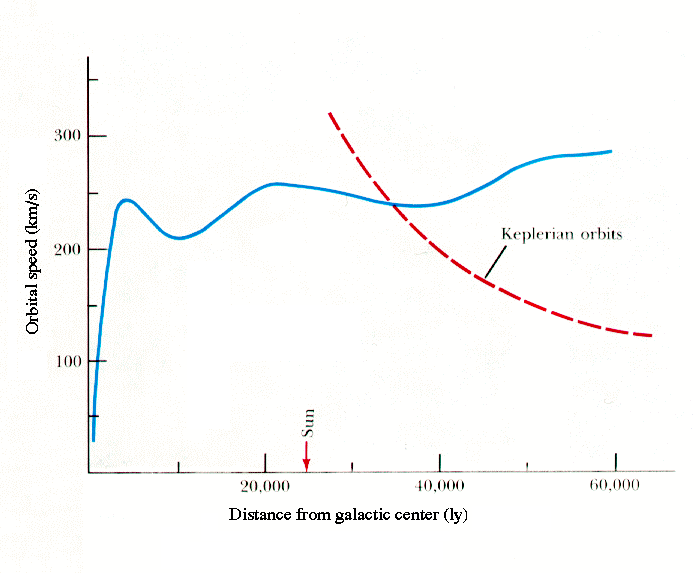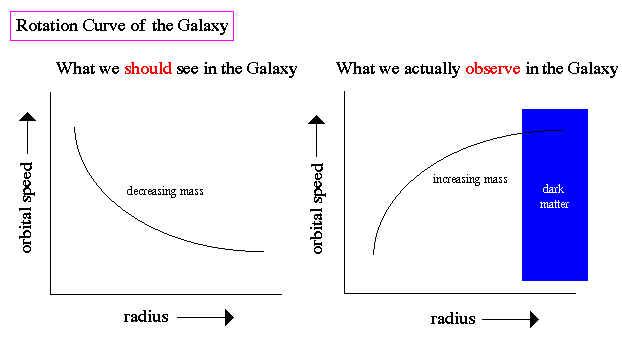
|
Milky Way:
| Readings: Schneider & Arny: Unit 70 |
| (Audio Lecture) |
A galaxy is a collection of stars and interstellar material held together by gravity. The galaxy our Sun lives in is called the Milky Way or the Galaxy (note the capital 'G'). The name `Milky Way' comes from the band of light that is seen overhead on very dark nights. The ancients called it the Celestial River. Galileo showed that the band is actually an edge-on concentration of stars seen looking through the disk of our Galaxy from the inside.

That same band looks very different when imaged at different wavelengths. For example, below is an image of the sky in the near-IR, sensitive to giant stars and dust.

The same region imaged in gamma-rays shows where all the neutron stars and x-ray binaries are found

The x-ray picture of our Galaxy shows where the hot supernova remnants are found (notice the partial arcs)

A deep optical picture shows where the dark nebula are found near the axis of the disk.

An image in the far-IR shows the concentration of old stars in the center of the Galaxy (called the bulge)

An an image taken at the 21-cm wavelength of neutral hydrogen shows how neutral gas avoids the center of the Galaxy and is found mostly out in the arms.

Size of the Milky Way:
Mapping of the Galaxy using star counts was shown to be ineffective due to the extinction of starlight by the interstellar medium.

A Harvard astronomer, H. Shapley, mapped the distribution of globular clusters in the Galaxy's halo to see where the Sun was with respect to the Galactic center. The distance to a globular cluster is found by main sequence fitting, where a HR diagram of a cluster is made and `slide' up and down to match the globular cluster main sequence luminosity to the absolute luminosity of the main sequence of nearby stars. The difference between the apparent and absolute luminosity determines the distance to the globular cluster.
When Shapley did this for 150 globular clusters he had the following plot.

The globular clusters orbit the center of the Galaxy, so where their centroid is on the plot is the Galactic center. The Sun is shown to be off center from the Galactic center by about 8 kiloparsecs or 25,000 light-years.
Later mapping of variable stars, neutral hydrogen radio maps and star clusters gives us our current view of the shape of our Galaxy shown below.

The key components of our Galaxy is a bulge of old stars in the center, a disk of stars and gas and a halo of globular clusters. The disk of our Galaxy is whirlpool shaped with numerous spiral arms spanning out from the center of the Galaxy. In the very center of the bulge of our Galaxy lies a nucleus, possibly a million solar mass black hole.
Notice that the total size of the Milky Way is about 50,000 light-years in radius, with the Sun a little over halfway from the center. Since the Galaxy is similar in shape to the solar system, we use a Galactic coordinate system where the plane of the disk forms the galactic equator. Angular distance from the center of the Galaxy eastward is galactic longitude, angular distance above or below the plane is galactic latitude
The orbital period of an object is just how far an object traveled divided by its velocity. In a circular orbit, how far is the circumference of the orbit such that the period, P, is
where r is the distance from the center and v is the velocity.
Since the Sun orbits the center of the Galaxy, we can use this knowledge to determine the mass of the Galaxy. Remember that Kepler's 3rd law states that the sum of the masses of two objects in orbit around each other is given by
Notice that the mass of the Sun is really, really small compared to the mass of the Galaxy. So MGalaxy + MSun becomes just MGalaxy.
Rotation Curve of Galaxy:
The orbital period of the Sun around the Galaxy gives us a mean mass for the amount of material inside the Sun's orbit. But a detailed plot of the orbital speed of the Galaxy as a function of radius reveals the distribution of mass within the Galaxy. The simplest type of rotation is wheel rotation shown below.

Rotation following Kepler's 3rd law is shown above as planet-like or differential rotation. Notice that the orbital speeds falls off as you go to greater radii within the Galaxy. This is called a Keplerian rotation curve.

To determine the rotation curve of the Galaxy, stars are not used due to interstellar extinction. Instead, 21-cm maps of neutral hydrogen are used. When this is done, one finds that the rotation curve of the Galaxy stays flat out to large distances, instead of falling off as in the figure above. This means that the mass of the Galaxy increases with increasing distance from the center.

The surprising thing is there is very little visible matter beyond the Sun's orbital distance from the center of the Galaxy. So the rotation curve of the Galaxy indicates a great deal of mass, but there is no light out there. We call this the dark matter problem, and states that the halo of our Galaxy is filled with a mysterious dark matter of unknown composition and type.

|
|

|